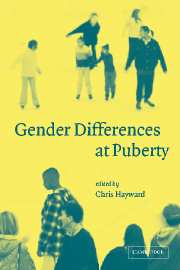Book contents
- Frontmatter
- Contents
- List of figures
- List of tables
- List of contributors
- Preface
- Acknowledgments
- 1 Methodological concerns in puberty-related research
- Part 1 Sex differences in hormones and their effect at puberty
- 2 The biology of puberty: new developments in sex differences
- 3 Hormonal changes at puberty and the emergence of gender differences in internalizing disorders
- Part 2 Girls at puberty
- Part 3 Boys at puberty
- Part 4 Puberty and psychopathology
- Part 5 Pubertal timing: antecedents
- Part 6 Pubertal timing: consequences
- Part 7 Puberty and context
- Index
- References
2 - The biology of puberty: new developments in sex differences
Published online by Cambridge University Press: 22 September 2009
- Frontmatter
- Contents
- List of figures
- List of tables
- List of contributors
- Preface
- Acknowledgments
- 1 Methodological concerns in puberty-related research
- Part 1 Sex differences in hormones and their effect at puberty
- 2 The biology of puberty: new developments in sex differences
- 3 Hormonal changes at puberty and the emergence of gender differences in internalizing disorders
- Part 2 Girls at puberty
- Part 3 Boys at puberty
- Part 4 Puberty and psychopathology
- Part 5 Pubertal timing: antecedents
- Part 6 Pubertal timing: consequences
- Part 7 Puberty and context
- Index
- References
Summary
At first glance puberty appears to be a discreet, isolated event that marks the transition from childhood to adulthood. In reality, though, it is part of a continuum of events that were initiated at conception. The hypothalamic gonadotropin releasing hormone (GnRH) pulse generator is initially active in fetal life and early infancy, but then suppressed during childhood; although at the onset of puberty it is reactivated. The etiology of this inhibition of the GnRH pulse generator is not known. It has been hypothesized that the onset of puberty is controlled by the brain “gonadostat,” which is a model used to describe the regulation of the hypothalamic GnRH pulse generator. Initially, in fetal life the gonadostat is insensitive to the negative feedback of gonadal sex steroids, testosterone in males and estrogen in females. But by the third trimester, the gonadostat has undergone some maturation and becomes sensitive to the high levels of estrogen and progesterone, and LH (luteinizing hormone) and FSH (follicle stimulating hormone) become suppressed. Through infancy and early childhood this sensitivity increases and the GnRH pulse generator is suppressed by the low levels of sex steroids. This feedback system is approximately ten times more sensitive to sex steroids than is the adult feedback mechanism (Styne and Grumbach, 1991). Then just prior to the onset of puberty, the sensitivity of the gonadostat to the negative feedback of gonadal sex steroids decreases, which releases the hypothalamic–pituitary axis from inhibition.
- Type
- Chapter
- Information
- Gender Differences at Puberty , pp. 17 - 28Publisher: Cambridge University PressPrint publication year: 2003
References
- 26
- Cited by

